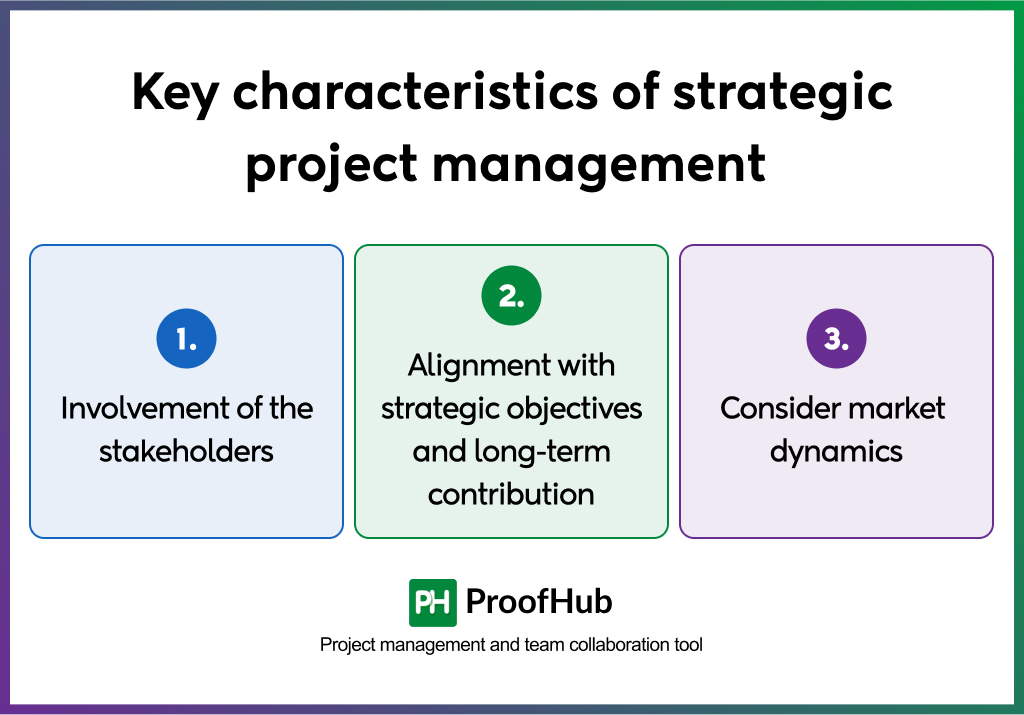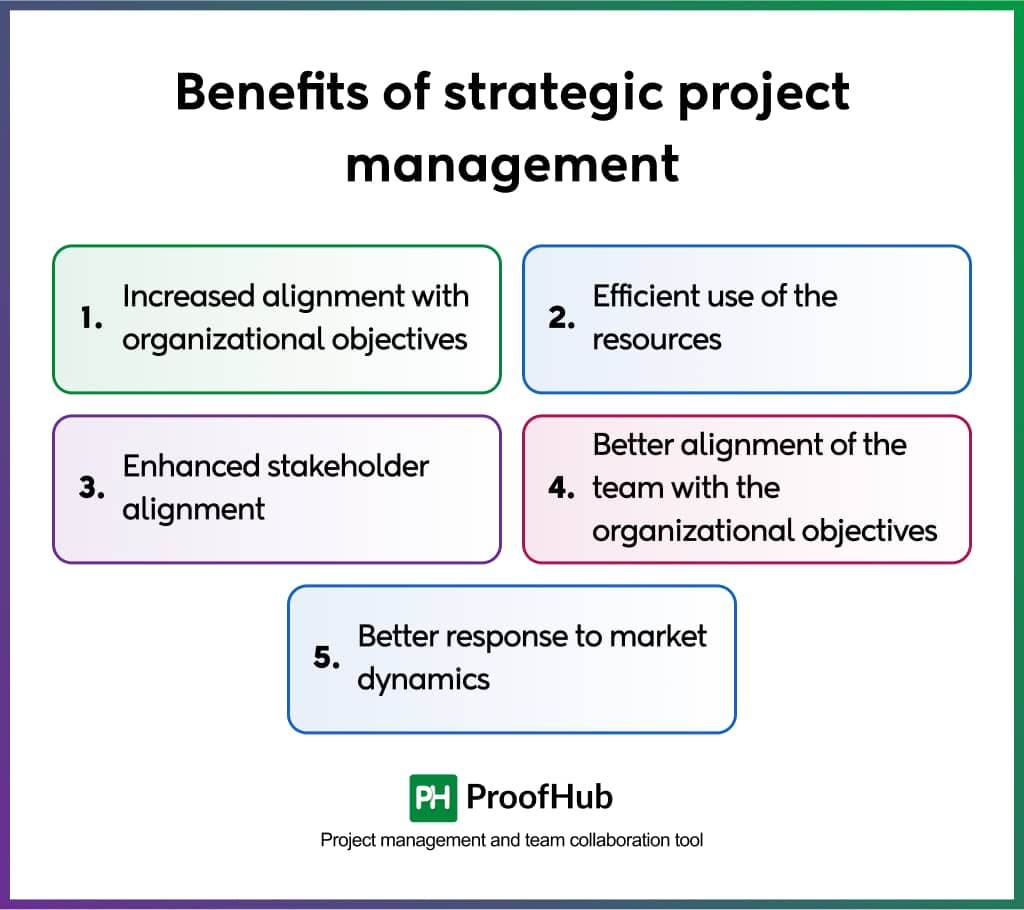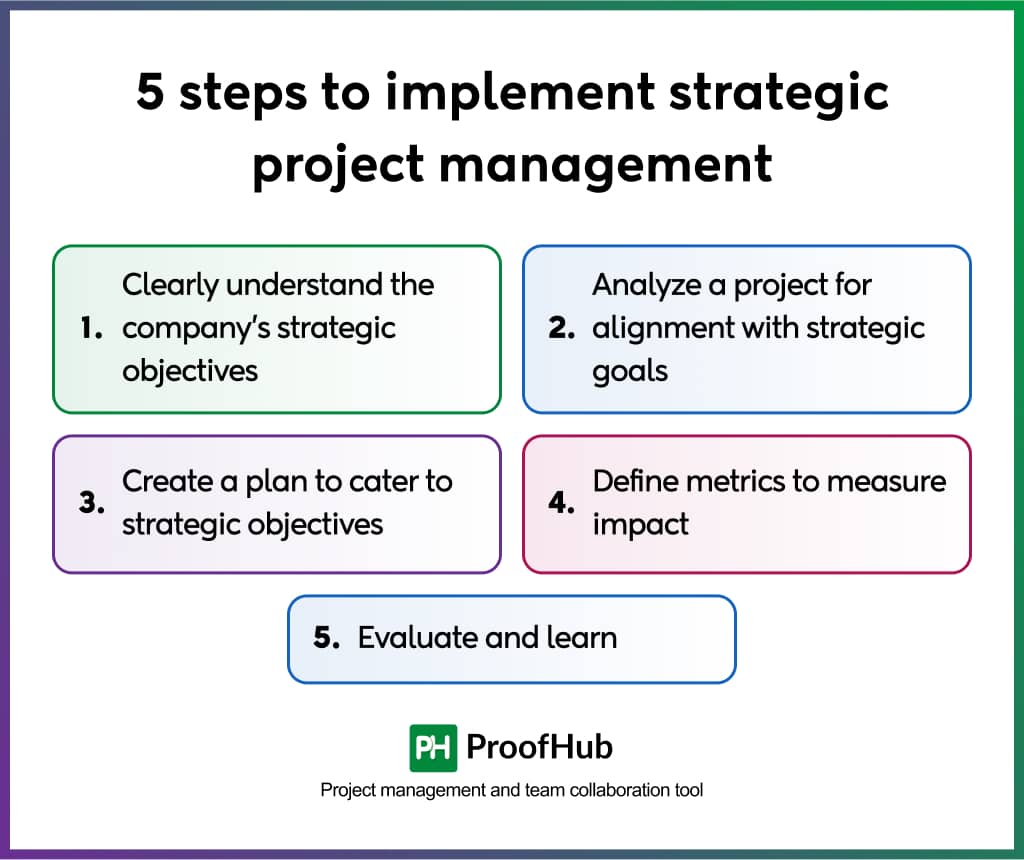Introduction
Every organization needs to maintain a steady pace of growth to counter the challenges posed by the market, irrespective of the industry. This objective of growth is often manifested in the form of strategic objectives of a company. To achieve these strategic objectives, the organization chooses and works on the projects that drive it in the direction of the set goals. This alignment of the company’s projects to the strategic objectives is defined as strategic project management.
Only a few organizations have realized the value of strategic project management (SPM). It is because most managers still think project management is about completing a project within budget and time of defined quality and agreed scope. It is true, but when combined with strategic planning, project management can be used by organizational leaders to improve the organization’s efficiency, ultimately achieving strategic objectives while ensuring growth and success.
In this post, we will understand how strategic project management helps make a project successful at the individual level while adding to the organization’s strategic objectives. We will learn about the tools and techniques to apply strategic project management to projects.
What is strategic project management?
Strategic project management (SPM) is a sub-discipline of project management that focuses on integrating strategic planning with project management. The purpose is to make sure projects are successful at the individual level as well as contributing to the organizational strategic objectives. In simple words, you can say that you are combining strategic planning and project management.
Strategic planning in project management can be defined as a systematic process of defining an organization’s long-term vision, setting strategic goals, and developing actionable plans to achieve those goals.
When combined with project management, it ensures a project is aligned with an overarching strategic mission and vision of the organization to ensure long-term success.
The purpose of SPM is to make sure each project is contributing to the organization’s strategic objectives. The principle of project management will remain the same, it is just the way doing things will be evolved.
For example, rather than simply asking, “How to complete a project within budget and time of agreed scope and defined quality”, you also ask questions like:
- How does this project align with the organization’s strategic mission and goals?
- Will it contribute to the organization’s long-term goals?
Read more: What is the project management triangle?
Key characteristics of strategic project management
There are certain things you do differently in strategic project management. Have a look at the key characteristics of strategic project management.

- Involvement of the stakeholders: In strategic project management, there is a strong emphasis on stakeholder involvement. Key stakeholders clearly define the company’s vision and mission, approve or disapprove the project based on the evaluation of a project’s contribution to the organization’s strategic objectives, and participate in project planning to align projects and employees to company strategy.
- Alignment with strategic objectives and long-term contribution: Strategic project management focuses on choosing and prioritizing projects in the portfolio that contribute to the organization’s strategic and long-term objectives, beyond the immediate benefits of project deliverables. Whereas project management focuses only on achieving individual project goals to make projects successful.
- Consider market dynamics: Strategic project management takes into account factors like market trends, external opportunities and threats, and end-user expectations to guide decision-making. Thus, you create strategies for project management considering these factors. The purpose is to ensure the organization has a strategic advantage for success.
What are the benefits of strategic project management?
Most organizations are not aware of the importance of strategic project management but it has a wide range of benefits for an organization. Have a look at them.

1. Increased alignment with organizational objectives
The biggest benefit of strategic project management is it helps a portfolio manager choose projects that are aligned with the business’s long-term, strategic goals. This ensures all the projects contribute directly to the organization’s success.
2. Efficient use of the resources
Strategic project management ensures the resources are allocated to initiatives with the highest strategic impact. This results in the efficient use of resources and helps you make the most of the company resources.
3. Enhanced stakeholder alignment
Strategic objectives are defined and set by the high-level stakeholders. When a project is aligned with the organizational strategic objectives and contributes to long-term success, it increases stakeholders’ buy-in and support. The enhanced engagement also leads to clarity and guidance by the stakeholders on the project to keep the project on track.
4. Better alignment of the team with the organizational objectives
Strategic project management thrives on the enhanced understanding of the project team, project manager, and project sponsors on the organizational strategic objectives, vision, mission, and strategy. Thus, it leads to enhanced alignment of each individual with the company’s strategic goals and better team performance. This ensures efforts are in the right direction, improving performance and effectiveness.
5. Better response to market dynamics
Another key benefit of strategic project management is the alignment of the projects to the market dynamics. Thus, project managers have better anticipation of market shifts and can gain competitive advantage by positioning the projects based on the understanding of the organizational needs. It ensures effective risk mitigation, leading to the success of a project in dynamic environments.
Read more: Why project management is important? Benefits, significance, and how to do it
What are the challenges in implementing strategic project management?
There are certain challenges one faces while implementing strategic project management. Have a look at them.
- Lack of clarity on strategic goals: If strategic goals are not clear and well-defined, it makes it difficult to align projects with strategic goals. This is because project team members may not fully understand the organization’s strategy or how their work contributes to it. This leads to misalignment between projects and strategic goals.
- Lack of buy-in from high-level stakeholders: The biggest challenge in strategic project management is the lack of buy-in from high-level stakeholders. They may define the strategic goals but it requires resources to act on these goals. Thus, strategic projects may struggle due to a lack of skilled resources, funding, or time, or projects are undertaken based on short-term needs.
- Resistance to change: Strategic project management requires cross-functional collaboration and involves cultural and process shifts. Those senior employees who are accustomed to working in silos can hinder coordination or traditional methods of working leading to resistance.
- Difficulty in measuring and showcasing strategic impact: Certain challenges are associated with the execution level. For example, there are no clear metrics that can evaluate the long-term strategic value of projects. It is easy to measure immediate impact with traditional metrics like a project’s on-time and on-budget delivery, but strategic KPIs like ROI, market growth, or customer satisfaction are complex to measure directly and take time to showcase results.
- Lack of technology to support strategic project management: Strategic project management requires transparency, collaboration, and the ability to align organizational strategic goals to project and project team goals. Thus, you need the right strategic project management tools and technology to support the strategic project management. Without it, you can talk about strategic project management but cannot implement it.
5 steps to implement strategic project management
There are certain things you need to do to implement strategic project management. Have a look at the steps to implement strategic project management.

1. Clearly understand the company’s strategic objectives
The first step of strategic project management is to clearly understand the company’s vision, mission, strategic objectives, and strategy. It will help you understand the priorities of a company and make project decisions based on the understanding gained.
For example, the company’s strategic and long-term objective is to, “achieve 30% market share in solar renewable energy in the next five years”.
Now, to achieve this objective, “a project to expand a company’s operations in emerging markets by forming strategic partnerships with local firms” makes more sense than “a project to increase the sales of solar panels directly to the customers.”
To gain a comprehensive understanding of a company’s strategic objectives and strategy, a project manager can seek clarity from the key stakeholders such as C-level executives.
Stakeholders can use the SMART framework to document the goal. SMART stands for specific, measurable, achievable, relevant, and time-bound. It makes sure everyone reading the goals understands what one is trying to achieve. Defining goals comprehensively also helps in choosing the projects from the project portfolio that serve the strategic objectives better.
Read more: Project objectives: how to achieve them effectively
2. Analyze a project for alignment with strategic goals
To implement strategic project management to projects, you need to make sure the company’s ongoing projects and upcoming projects are aligned with the strategic objectives. The best way to do so is to evaluate the strategic relevance of projects during the planning phase, define how the project outcomes contribute to the larger goals, and get approval from the high-level stakeholders.
Strategic project planning helps you align the project to overarching goals while ensuring a project meets its individual and immediate objectives. There are certain techniques and methods you can use to analyze the strategic relevance of the projects:
- SWOT analysis: It identifies and evaluates a project’s internal strengths and weaknesses and external opportunities and threats.
- PESTLE analysis: It evaluates a project’s impact on Political, Economic, Social, Technological, Legal, and Environmental factors.
- Balanced scorecard: It links projects to strategic goals using perspectives like financial, customer, internal processes, and learning & growth.
- Benefits dependency map: It helps you connect project deliverables to organizational objectives and measure the actual outcomes versus expected strategic benefits.
- Scenario planning: Techniques like Monte Carlo Simulation or Decision Tree help you evaluate possible outcomes of a project and ensure project decisions align with strategic priorities.
3. Create a plan to cater to strategic objectives
Just aligning a project to strategic objectives is not enough. To ensure a project caters to the overarching strategic objectives, you need to incorporate strategic objectives into a project plan and clearly define how the project outcomes will contribute to the larger goals. This project management strategy helps you secure resources for the additional work you need to complete in a project to fulfill strategic objectives, build flexibility into the plan to adapt to strategic shifts if there are any, and justify your decisions throughout the project lifecycle.
4. Define metrics to measure impact
It is not difficult for a project to veer off the course in the absence of monitoring and control. Therefore, it is important to track, monitor, and control the project’s strategic progress to ensure it stays on track. To do so, you need to set OKRs for a project to create measurable goals and define the metrics and KPIs to measure the project’s contribution to strategic objectives.
For example, the OKRs of a project can be to create a marketing campaign to achieve a market share of 30% in solar renewable energy in the next five years. The metrics and KPIs to measure strategic success can be market share growth.
These metrics and KPIs not only help you in progress tracking and making decisions to keep projects on track but also in stakeholder communication. They provide a common measure to report the progress to stakeholders and ensure consistent communication about how the project contributes to their goals.
5. Evaluate and learn
Strategic project management is not a one-time exercise that you do annually by defining the company’s strategic objectives and never talking about how it is executed in the projects. It is more about the consistent efforts throughout the project lifecycle to ensure a project is aligned with strategic objectives. Thus, you need to evaluate the strategic impact of the initiatives in post-project reviews or critical milestones of the project. It helps you measure the impact, document the lessons learned, and suggest improvements for future alignment.
Using these five simple strategies for effective project management you can implement strategic project management that can create a real impact.
Examples of strategic project management
You are a large energy corporation, X, that currently operates in fossil fuels but wants to expand into renewable energy. You decided to achieve a market share of 10% in solar renewable energy in the next two years. So, the company decided to launch a Solar Energy Initiative aimed at building a large-scale solar farm.
Traditional project management will focus on delivering the solar farm on time, within budget, of defined quality, and as per scope.
However, strategic project management not only focuses on project execution but also considers how the project aligns with the company’s long-term vision.
Say, the company’s long-term vision is to achieve a market share of 30% in solar renewable energy in the next five years.
A strategic project manager will now plan the same project to build a large-scale solar farm keeping the organization’s long-term and strategic needs in mind.
This can be done in many ways. For example, may be redefining the scope and creating a solar farm that can be expanded to fulfill long-term needs.
This is just one aspect a strategic project manager will also consider:
- Market trends, government incentives, and competitive positioning before starting the project.
- External factors like carbon credit policies, customer demand, and investor expectations.
- Measuring success not just by completion but also by strategic impact: market share in renewable energy, alignment with government sustainability goals & long-term profitability, and brand positioning as an eco-friendly energy provider
Project management practices will remain the same and you do not need some additional project management skills, it is just things that will be managed holistically considering strategic planning.
Read more: 28 Project management skills a project manager must have
How to implement strategic project management with ProofHub?
ProofHub is an all-in-one project management and team collaboration software that helps you manage projects, stakeholders, and project team members from one place. It is best strategic project management software that can help you in a following way:
- Define strategic objectives with stakeholders discussion: ProofHub allows you to set SMART strategic goals and define strategic objectives. All the stakeholders can participate in the discussion to define strategic goals and define selection criteria for accepting, rejecting, or prioritizing the projects from the project portfolio.
- Create and align projects to strategic goals: ProofHub allows you to create projects, define their contribution to strategic goals, set budgets, estimate time, and assign resources to create a detailed project management plan. With features like the Gantt chart, you can visualize the project plan on the timeline, set milestones, and define dependencies, making the project planning process easy.
- Track progress with KPIs and metrics: With ProofHub reports, you can track project, team, and overall organization’s progress and performance from different angles using various KPIs and metrics. It helps you make data-driven decisions, prioritize projects, redirect resources, and manage resources.
- Facilitate communication: ProofHub brings all the project data to one place. This makes it easy for everyone working on the project to collaborate, be on the same page, and create a shared understanding. With multiple channels for communication and project collaboration such as chat, task comments, and project files, ProofHub facilitates collaboration among cross-functional teams.
- Involve stakeholders: With custom access and roles, ProofHub allows both internal and external stakeholders to onboard the projects and engage directly in projects. It ensures project and individual alignment to strategic goals with direct insights from stakeholders. With all the projects in one place, ProofHub makes project portfolio management easy.
Frequently asked questions
Why is strategic project management important?
Strategic project management plays an important role in the organization’s success by aligning individual project outcomes to the organizational strategic objectives. It combines project management with strategic planning to ensure every project aligns with the organization’s strategic mission, vision, and strategy.
What are the best practices for strategic project management?
Certain practices you can follow for strategic project management such as involving stakeholders throughout the project lifecycle, clearing the roles and contribution of team members to the strategic objectives, and bringing everyone to the same page with standard documents, processes, and project management methodologies.
How do you measure the success of strategic project management?
The success of strategic project management is measured with long-term metrics and market KPIs such as ROI, market share, and customer satisfaction score. However, the metrics and KPIs change from one industry to another.

